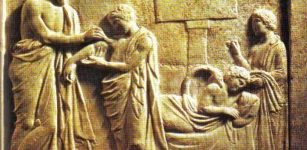Legend Of Marguerite de Bressieux: Brave Noblewoman Who Sought Revenge For Sexual Assault
A. Sutherland - AncientPages.com - They say it is only a legend, nothing more. You can believe it or not. Still, it could be a true story that could happen in any location at any time.
Ruins of Anjou Castle. The castle has a long history. With this castle is associated the memory of the Edict of Roussillon (August 8, 1564) by which Charles IX and Catherine de Medici imposed the date of January 1 as the first day of the year for the entire kingdom of France. Sold shortly after the Revolution, the castle of Anjou was largely destroyed between 1806 and 1813. Credit: Raydou - CC BY-SA 4.0
According to Humbert de Terrebasse (1842-1927), a lawyer and historian, this event took place during the Hundred Years' War (1337 - 1453), a struggle between England and France over a series of disputes, including the question of the legitimate succession to the French crown.
Ruins of Anjou Castle. The castle has a long history. With this castle is associated the memory of the Edict of Roussillon (August 8, 1564), by which Charles IX and Catherine de Medici imposed the date of January 1 as the first day of the year for the entire kingdom of France. Sold shortly after the Revolution, the castle of Anjou was largely destroyed between 1806 and 1813. Credit: Raydou - CC BY-SA 4.0
Marguerite de Bressieux was a French noblewoman born in Anjou, France, and lived in a castle with her parents.
The legend says that the castle was besieged and pillaged by rebel troops attempting to topple King Charles VII on behalf of a Burgundian nobleman, Louis de Chalon, the Prince of Orange.
Marguerite's father and mother were killed. The soldiers of Chalon raped her, her ladies-in-waiting, and other noblewomen. Marguerite buried the parents and then swore bloody revenge on Chalon and his ruthless men, whose shameless act proved to be the last they had committed.
However, they were not yet aware of what awaited them. Soon after the tragic incident, Marguerite and her ladies-in-waiting armed themselves and started military training that included riding in battle and sword fighting. Deeply motivated and ready to fight, they had only waited for the chance to encounter Chalon and his men in a competition.
Luckily, the women did not have to wait long. Finally, the king was ready to retaliate against Louis. When Marguerite heard that royal troops led by Raoul de Gaucort, governor of the Dauphiné, were being assembled to march against Chalon's soldiers, she made necessary preparations for the departure of her small group of female warriors in disguise.
Clad in black with faces covered with black scarves and with a pike or lance in one hand, they mounted their horses. One held a black banner decorated with heads superimposed over bones and silver tears. In the middle of these funeral emblems, there was an orange pierced by a spear, under which an inscription was visible: "Ainsi tu seras" ("Thus shall you be").
The orange was associated with Louis Chalon, the Prince of Orange.
Led by Marguerite de Bressieux, these brave women were perfectly aware of war risks and would not be denied their revenge.
At first, Gaucourt hesitated to allow Marguerite and her companions into his army but listened carefully to what the women had to say.
"Deign, noble lord, to accord us a place in your ranks. If our arms are weak, our hearts are strong and bent upon nothing but vengeance. Victims of the most cowardly, the most degrading outrage, we aspire to wash it out in blood." 1
Gaucort respected the determination of Marguerite and her companions and let them join the troops of King Charles VII on their way to encounter Chalon, Prince of Orange, and his men. Now a confrontation was imminent, and when it took place, Chalon's soldiers were surprised and could not believe their eyes.
They took the female warriors for frightening ghosts, who emerged from hell to take revenge on the living, but the women were real.
The black horse riders in disguise raised their visors before Chalon and his team. They bravely looked into the eyes of each of their rapists, who fled, terrified of fighting ghosts. They were chased by the royal troops who massacred them mercilessly, pushing the last of them into the Rhône River.
The legend further tells that Marguerite was deadly wounded in battle and had to wait for help for too long. Finally, her companions took her to a nearby convent, but she died several hours later.
She was buried with military funeral honors, and her companions decided to stay in the convent for the rest of their lives.
According to the legend, it happened in 1450 in France during the Hundred Years' War (1337-1453).
Updated on December 27, 2023
Written by – A. Sutherland - AncientPages.com Senior Staff Writer
Copyright © AncientPages.com All rights reserved. This material may not be published, broadcast, rewritten or redistributed in whole or part without the express written permission of AncientPages.com
Expand for referencesReferences:
- Schmermund E. Women Warriors
More From Ancient Pages
-
 Why Was It Necessary For Great Physician Hippocrates To Eat Earwax?
Ancient History Facts | Aug 14, 2017
Why Was It Necessary For Great Physician Hippocrates To Eat Earwax?
Ancient History Facts | Aug 14, 2017 -
 Prehistoric Artifacts Out Of Nowhere -Their Origin And Purpose Are Totally Unknown
Artifacts | Jun 23, 2012
Prehistoric Artifacts Out Of Nowhere -Their Origin And Purpose Are Totally Unknown
Artifacts | Jun 23, 2012 -
 Why Is A Biscuit Named After Giuseppe Garibaldi – Italy’s Military Leader And Hero?
Ancient History Facts | Feb 19, 2017
Why Is A Biscuit Named After Giuseppe Garibaldi – Italy’s Military Leader And Hero?
Ancient History Facts | Feb 19, 2017 -
 Starkad The Viking – Legendary Norse Hero Who Was Both Blessed And Cursed By Gods
Featured Stories | Jul 29, 2019
Starkad The Viking – Legendary Norse Hero Who Was Both Blessed And Cursed By Gods
Featured Stories | Jul 29, 2019 -
 Mysterious Gigantic Jars Of Unknown Origin Discovered Worldwide
Artifacts | Dec 27, 2018
Mysterious Gigantic Jars Of Unknown Origin Discovered Worldwide
Artifacts | Dec 27, 2018 -
 Florida’s Ancient Underwater Burial Site Much Older Than Previously Thought
Archaeology | Jun 24, 2019
Florida’s Ancient Underwater Burial Site Much Older Than Previously Thought
Archaeology | Jun 24, 2019 -
 Cooking, Roasting And Eating Of Root Plants Is 120,000-Year-Old Habit
Archaeology | Jun 7, 2019
Cooking, Roasting And Eating Of Root Plants Is 120,000-Year-Old Habit
Archaeology | Jun 7, 2019 -
 4,000-Year-Old Lunar Calendar Developed At Kokino Megalithic Observatory – Evidence Of Remarkable Astronomical Knowledge
Archaeoastronomy | Jan 9, 2021
4,000-Year-Old Lunar Calendar Developed At Kokino Megalithic Observatory – Evidence Of Remarkable Astronomical Knowledge
Archaeoastronomy | Jan 9, 2021 -
 Paititi: Legendary Lost Inca City Of Gold Built By The Inca Hero Inkarri
Featured Stories | Mar 16, 2016
Paititi: Legendary Lost Inca City Of Gold Built By The Inca Hero Inkarri
Featured Stories | Mar 16, 2016 -
 Mysterious Ancient Figure Depicted On A Jade Cong May Re-Write History Of China
Artifacts | Oct 11, 2019
Mysterious Ancient Figure Depicted On A Jade Cong May Re-Write History Of China
Artifacts | Oct 11, 2019 -
 Riddle Of The Two Calicuts And How We Got History Wrong
Archaeology | Jan 20, 2023
Riddle Of The Two Calicuts And How We Got History Wrong
Archaeology | Jan 20, 2023 -
 Unique Chachabamba Complex Hidden In Peruvian Forest Reveals Its Secrets
Archaeology | Feb 7, 2019
Unique Chachabamba Complex Hidden In Peruvian Forest Reveals Its Secrets
Archaeology | Feb 7, 2019 -
 The Anglo-Saxon Migration: New Insights From Genetics
Archaeology | Sep 21, 2022
The Anglo-Saxon Migration: New Insights From Genetics
Archaeology | Sep 21, 2022 -
 Suprising Evolution Discovery – Human Temporal Lobes Are Not Very Large In Comparison With Other Primates
Archaeology | Mar 21, 2023
Suprising Evolution Discovery – Human Temporal Lobes Are Not Very Large In Comparison With Other Primates
Archaeology | Mar 21, 2023 -
 Surprising End To Legend Of The Snallygaster That Terrorized Maryland And Washington
Featured Stories | Jun 1, 2020
Surprising End To Legend Of The Snallygaster That Terrorized Maryland And Washington
Featured Stories | Jun 1, 2020 -
 Xochicalco: Stunning Ruins Of Sacred City Linked To Maya and Aztecs Civilizations
Featured Stories | Feb 26, 2018
Xochicalco: Stunning Ruins Of Sacred City Linked To Maya and Aztecs Civilizations
Featured Stories | Feb 26, 2018 -
 Evidence Humans Walked The Great Plains 18,000 Years Ago May Have Been Found – Archaeologists Say
Archaeology | Mar 14, 2022
Evidence Humans Walked The Great Plains 18,000 Years Ago May Have Been Found – Archaeologists Say
Archaeology | Mar 14, 2022 -
 ‘Incredibly Mysterious’ Bronze Age Gold Penannular Ring Found In Norfolk
Archaeology | Apr 24, 2023
‘Incredibly Mysterious’ Bronze Age Gold Penannular Ring Found In Norfolk
Archaeology | Apr 24, 2023 -
 Roman Square Capitals: Prestigious Script That Delighted Human Eye With Its Elegance
Featured Stories | Sep 16, 2019
Roman Square Capitals: Prestigious Script That Delighted Human Eye With Its Elegance
Featured Stories | Sep 16, 2019 -
 Forbidden Knowledge: Secret Ancient Gates Of The Shining Ones – Geomantic Energy Vortices – Part 2
Featured Stories | Jul 16, 2019
Forbidden Knowledge: Secret Ancient Gates Of The Shining Ones – Geomantic Energy Vortices – Part 2
Featured Stories | Jul 16, 2019


